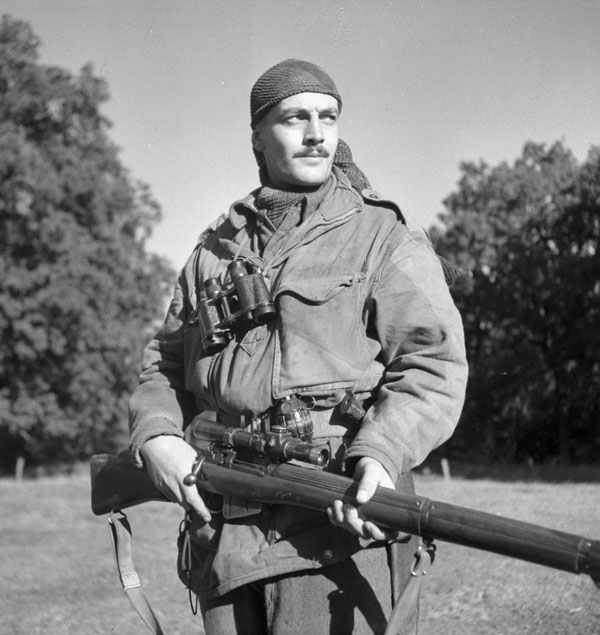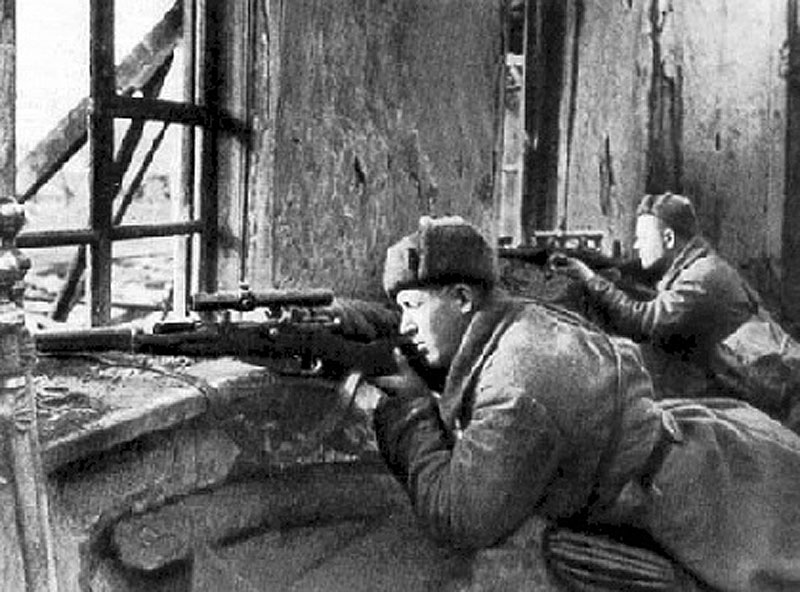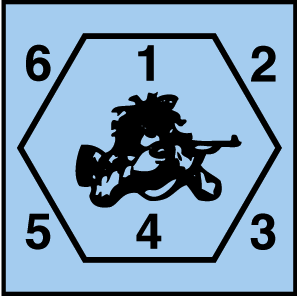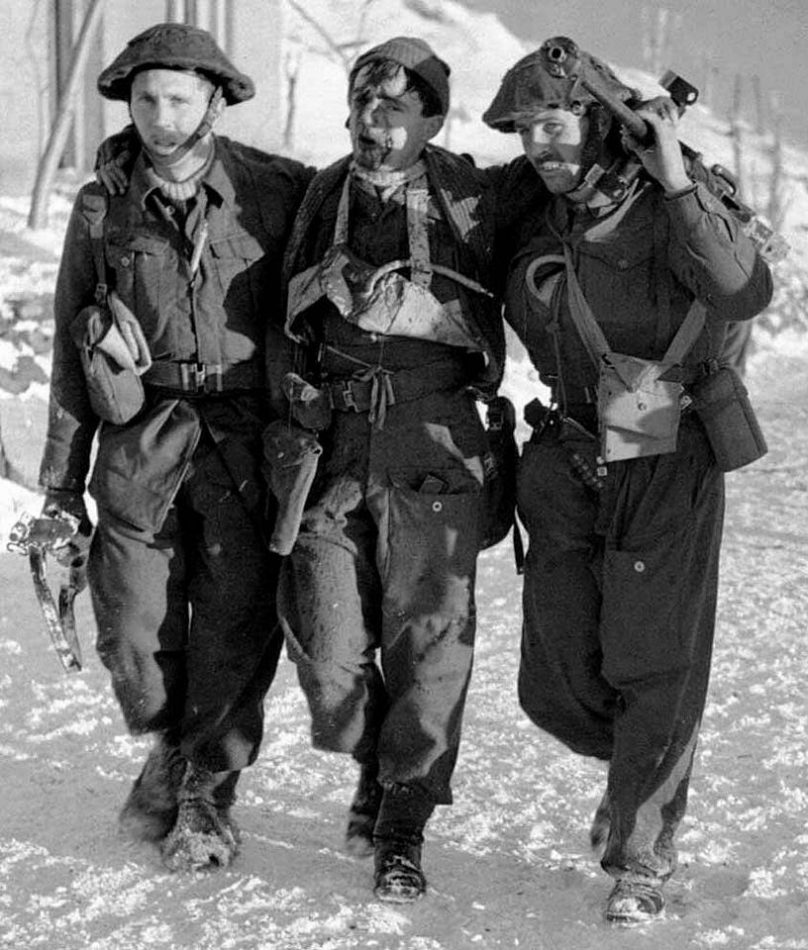Snipers in Advanced Squad Leader
By David Garvin
Snipers are an important part of modern war, having gained great importance in the Second World War. , trained to provide highly detailed intelligence on the enemy and engage him only if the opportunity presents itself.
However, in World War Two they were largely employed as marksmen, trained to shoot a man-sized target out to about 300 yards, often with only using iron sights. In practically every tactical-level war game that I have played, snipers have often been ignored. It is a tricky problem as to how to mimic the effect of a single rifle-armed soldier taking that one shot that alters the fate of a battle.
Not all games ignore them, however, and in this article, I will show how that aforementioned problem was dealt with by the developers of . In so doing, I will explore back through the original Squad Leader system and how it first tackled the problem. Finally, I will give an anecdote about how it affected me, the human player, in one memorable match I played many years ago.
We have our best men working on the problem!As I previously stated, Squad Leader was released to the gaming world in 1977 and it was an immediate smash hit. Its box was engaging and on the back, there was a snippet of a short story, meant to garner interest in the game. It starts off : “A shot disturbs the eerie silence of a deserted city street, punctuated by the frantic footfalls of men seeking cover. One of Kruger’s last veteran NCO’s lies motionless in the street.” The author is quite clearly describing a sniper attack and its effects. Ironically, it was impossible to game that situation in the original Squad Leader; it wasn’t until 1978’s Cross of Iron that rule 96 SNIPERS was introduced.
Snipers are introduced into Squad LeaderSnipers added a bit of drama to the game and in Cross of Iron, the player had direct control over the sniper to include where he was placed and whom and when he attacked. Essentially the sniper counter was placed using Hidden Initial Placement (HIP), and when he felt that it was time for the sniper to attack, the player would announce it, roll the dice and consult the charts to see the result.
More often than not, snipers tended to be most dangerous to enemy infantry moving in the open and within 8 hexes, which comes out to just about 300 yards. Given the optics available at the time and the training that many snipers received, this is a respectable distance. Once discovered, likely by doing a sniper check, the sniper had lost all special abilities and would simply become another enemy unit, until such time that the unit could again become concealed; it could never regain its HIP status.

In terms of the effect on the game, I personally found with Cross of Iron that snipers were most effective when they were not shooting. Until the first shot rang out, my opponent would have no idea where I had placed my sniper. I found that my opponent would be cautious in his moves, darting from cover to cover.
The fear of the unknown was a powerful weapon and the use of the sniper in Cross of Iron and the later was best so employed. Once the attack was made, however, my opponent knew that the sniper was within the cover and within 8 hexes of the target, and within line of sight.
The fog had somewhat lifted! By the rule, the sniper could only attack one counter in the target hex. If the target was another sniper or a leader, then that target could be eliminated. If the target was a squad or a crew, then the most it could do would be to invoke a morale check. And more often than not, the attack was to no effect.

With the release of 1985’s , the sniper had greatly evolved. No longer did the player have direct control over whom and when his sniper attacked. In fact, wherein Squad Leader the sniper was only a factor if included in the order-of-battle, in ASL, the sniper is inherent in almost every scenario and for both players.
Rule A14 SNIPERS is quite succinct in its introduction to the rule: “Snipers are an inherent part of every scenario OB that has a designated SAN (14.1) of ? 2. Snipers are not represented by Personnel Counters and are not subject to the complete control of either player.
A Sniper counter is not a unit, and cannot be used to claim LOS.” The rule for snipers is about a page or so in the rule book. In essence, the sniper is represented by a counter that both sides will place as part of the scenario set up. There are restrictions on where it can go and the like, but in general, it represents the area of greatest concern for a player. As an example, if I felt that I needed to influence my enemy’s left flank, I’ll likely place my sniper counter in that area.

Once placed, the snipers will attack based on a random event. In certain phases of the game, if player A rolls player B’s SAN, then there is a possibility of a sniper attack. Through a series of die and dice rolls, players will determine first if there is a possibility of an attack, then if that attack occurs, and if so, what effect it could have and then the target is randomly determined. It sounds like a complex series of events but in the end, even novice players will quickly resolve any and all attacks. The main difference between the snipers of Squad Leader and ASL is that in ASL, while a Sniper Activation may not always invoke an attack, a sniper attack will always have a result. The results include elimination of a single man counter, dummies or snipers, Stun and recall a CE AFV Crew, breaking a multi-man counter, or even immobilizing an unarmored vehicle.
“How the heck did a Sniper make that tank go back to Regiment?”The effect of the sniper on any scenario of ASL varies. It is all dependent on the Sniper Activation Number (SAN) value. Every scenario that has a SAN will have a value between 2 and 7. In order to activate a sniper attack, a player will have to roll his opponent’s SAN value in certain rolls during any phase in which a fire attack can be made. Statistically, a SAN of 2 will be hit only once in every 36 rolls. Generally speaking, after hitting the enemy SAN, there is a one-third chance of a successful attack.
Statisticians will tell you that with a SAN of 2, there is only a 1 in 108 chance of a successful enemy attack on every dice roll in an eligible phase. For the rare occasion, there is a SAN of 7, those odds decrease (or increase, depending on your point of view), to 1 in 18 on every dice roll. That’s about a 5.5% chance. Every single roll. That said, dice being fickle and all, I have seen games with high SAN go without a single successful attack, and those with a SAN of 2 see several successful attacks. I always seem to be on the receiving end of those low-odds attacks!
The effect of the SAN on the game is pretty much an accurate reflection of what the designers of ASL intended. If there are plenty of snipers about, then the wise player will reduce the opportunity for the enemy to shoot: he will seek cover, he will spread out, and will only shoot when absolutely necessary. Conversely, if the SAN is low, then the bold player will take more risks, although never totally ignoring the threat.

I recall one particular match of ASL that I had a while back and it highlighted to me just how important snipers could be for a game. The battle was set in Aachen in 1944, and as the attacking American, I had an overwhelming combat power advantage. I outnumbered the defending Germans by a 2:1 ratio in squads and had a good leader-to-squad ratio of about 1:5.
I also had 3 Sherman tanks. Even though these Germans were well-armed with Panzerfausts and other anti-tank weapons, I had the advantage by almost every metric: firepower, range, and Experience Level Rating (ELR). But there was one number that stood out to me as the American: the German SAN was 6. At the time, I never fully realized what this meant: every fire attack, every morale check, and even task check that I would take, there would be a 5 in 36 chance to hit his SAN.
That comes to about a 14% chance for every dice roll to check for a sniper attack. Boiled down further, that meant a successful German sniper attack about once every twenty rolls. With ten game turns, and even with only say 5 eligible dice rolls per player turn, that’s over a hundred rolls and on average, five successful sniper attacks!
“You shouldn’t have prep-fired so much with a SAN of 6, Garvin”As it turns out, I won the game. It was the tenth time that I played my primary ASL mentor, Alain, and only the third time I beat him. The game is fairly evenly matched with the win/loss ratio being 104 wins for the US and 102 wins for the Germans as I write this article.
The biggest lesson I learned from this match was the power of a high enemy SAN. I learned it in-game and it affected my play immediately after his first successful – and devastating – Sniper attack. At the start of the game, I had a fairly good plan that ended up working for me in spite of my many errors along the way. In short, it was right-flanking with infantry leading the tanks.
The significant event happened when one of my attacks rolled a 6; his SAN. Of course, he rolled a 1 and hit what players refer to as a “Big Sniper”. The target selection process is random and of course, he landed on the stack that had just fired. It had my best leader, a 9-1. It also had 3 squads and 3 machine guns. By random selection, the sniper shot and eliminated my leader. This triggered a leader-loss morale check for my squads, all of whom failed. With just one shot, by a well-placed sniper, my firebase that was clearing a path for my attack was quite suddenly rendered useless by one bullet. Welcome to ASL!
Moments before Garvin’s firebase is attacked by Alain’s sniperSo, if you’re looking for a sniper game that has a realistic and profound effect on a tactical game, then ASL may be just the thing for you. You won’t be able to pull the trigger as your sniper makes the shot; all you can do is set the conditions to allow him to do just that. As you learn the game, you will learn how to use your sniper to great effect, and also how to mitigate the threat, and even how to eliminate it!
There are many players out there, much better than I, who have much better specific advice as to how to use snipers in the game. But I do know this: a well-executed sniper game – with a bit of luck – can turn a game around for you with a single dice roll. It’s happened to me and it will happen to you!
David Garvin is an ASL gamer and lives in Nova Scotia. He’s definitely not a sniper, but he has learned to respect them!
